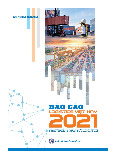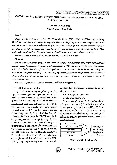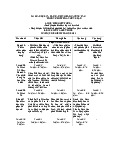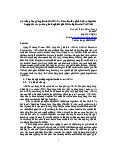







Preview text:
See discussions, stats, and author profiles for this publication at: https://www.researchgate.net/publication/341989787
Understanding the IKEA Warehouse Processes and Modeling Using Modular Petri Nets
ArticleinInternational Journal of Simulation: Systems, Science & Technology · March 2020 DOI: 10.5013/IJSSST.a.21.02.03 CITATIONS READS 4 9,900 3 authors: Behfar Behzad Maryam Farzad University of Stavanger (UiS) University of Stavanger (UiS) 2 5
PUBLICATIONS CITATIONS 1 4
PUBLICATION CITATIONS SEE PROFILE SEE PROFILE Reggie Davidrajuh University of Stavanger (UiS) 175 957 PUBLICATIONS CITATIONS SEE PROFILE
All content following this page was uploaded by Behfar Behzad on 19 November 2020.
The user has requested enhancement of the downloaded file. BEHFAR BEHZAD
: UNDERSTANDING THE IKEA WAREHOUSE PROCESSES AND MODELING USING . .
Understanding the IKEA Warehouse Processes and Modeling using Modular Petri Nets
Behfar Behzad, Maryam Farzad, Reggie Davidrajuh
, University of Stavanger, Stavanger, Norway.
B.Behzad@stud.uis.no; M.Farzad@stud.uis.no; Reggie.Davidrajuh@uis.no
- Nowadays, large warehouses handle a huge number of products. Handling the enormity and different types of (range)
products also demand complex warehouse processes. In this paper, the IKEA warehouse in Stavanger, Norway, is taken as an
example, which stores, manages, and sells ready-to-assemble furniture, kitchen appliances and home accessories. The focus of this
paper is to understand the warehouse processes that make the warehouse popular with the customers. Petri net is used to model the
processes, and by simulation, the effect of the processes are understood. This paper shows how the processes integrate the large
range of products, customer service, and the supply chain. The logistics flow is represented with a modular Petri Net model using
the tool known as the General-purpose Petri Net Simulator (GPenSim). The goal of this paper is also to determine and propose any
changes for a more efficient warehouse performance. I. INTRODUCTION
transportation of products (e.g., to and from the warehouse).
Formally, warehouse processes are defined as the core of
IKEA is a globally known Swedish company that
the logistics of an enterprise that acts between the
currently is the world’s largest home furnishings retailer.
production and distribution activities [1], [2], [3]. Whereas,
IKEA mainly focuses on offering a wide range of good
logistics is defined as the processes that involve the
quality, well designed and functional products that are not
operations for inventory and transport of goods [4], [5].
only affordable in comparison to other competitors but also
A general literature review on warehouse performance is
has an attractive and creative blueprint. However, without
done by [6], [7], [8] discussing warehouse performance
having a proper and on-time distribution through the store,
indicators such as time, quality, cost, and productivity. [9]
the reputation might get deteriorated and consequently
studies the influence of warehouse processes on supply
customer dissatisfaction. The logistical and warehouse
chain performance. This work especially focuses on
processes are the heart of the store as it is responsible for
software that can improve the efficiency of the processes.
handling, off-loading and arranging the goods. The
[10] discusses warehouse management system as an
movement of products in the IKEA store must be as
information system that is indispensable for efficient
efficient as possible to maintain uninterrupted sales.
management of warehouse and logistics processes. This
In this paper: Section-II starts with a short literature
work considers the warehouse management system as a
review of related works. Also given in this section is the
subset of logistics information systems.
warehouse and logistical processes involved in large
There are not many works that are related to
warehouses. SectionIII develops a modular Petri Net model
warehousing modeling and simulation. However, [11]
of the warehouse. Section-IV implements the model with
resembles closely to this paper. The difference between [11]
GPenSIM, and a summary of the simulation results are also
and this paper is the following: [11] focuses on the Petri net given.
model and the warehouse processes are kept in the
background (invisible), whereas this paper focuses on the II. WAREHOUSE PROCESSES
warehouse processes. Also, the warehouse processes are
studied by direct observations rather than based on the
First, a short literature review of related works is given. literature.
For successful operation of a warehouse (e.g., IKEA),
Fig.1 shows a simplified warehouse processes. Large
both the warehouse processes and logistics must work hand
warehouses manage a sheer volume of goods every day.
in hand. Warehouse processes and logistics are closely
Taking IKEA-Stavanger as an example, the staff starts
related, yet two different functions within the supply chain.
working at 6 A.M., and they have to finish all the tasks
A warehouse process is mainly about the storage of
before 10 A.M. when the doors get opened, and customers
products within the storage area, whereas logistics is about
start arriving. If any task remains unfinished by 10 A.M.,
DOI 10.5013/IJSSST.a.21.02.03 3.1 ISSN: 1473-804x online, 1473-8031 print BEHFAR BEHZAD
: UNDERSTANDING THE IKEA WAREHOUSE PROCESSES AND MODELING USING . .
the task will be postponed until next shift because the
of the barcode on them. The barcode itself has all the
movement of goods by driving forklifts between the shelves
information regarding the section, the row and the shelf they can endanger customers. are going to be located.
Usually, IKEA retail shops also function as warehouses.
In some cities like Stavanger, there is a separate and bigger Right after the pallets are
warehouse near to the retail shop; the warehouse is only a
unloaded, and processed, registered, and validated by
two minute drive from the retail shop. The warehouse
barcode scanning, they are ready to be transferred to their
contains bulky items which are difficult for customers to
final position in the shelves. A forklift will be used to load into
transport the products to the pre-defined location in the
shelves. The shelves are grouped into three main sections:
• The stock section is where the extra products are kept
in case of the need for replenishment in the marketing hall,
where only one sample is kept.
• Order section is filled according to the customer’s
ordering. In this section, the products will be stored and
kept for a maximum of one week, waiting for the customer to pick them.
• The marketing hall contains two floors. The first floor
mostly includes kitchen appliances, home and bathroom
utensil, and the smaller decoration items. The second floor
generally contains bulky and heavy items like furniture,
beds, oven and refrigerator, and other significantly large objects. Once the
packages are settled into their corresponding sections, there
will be three different paths between the sections. The inter-
section transportation scheme is to transport products
between the sections quickly. For shorter paths (e.g.,
Fig. 1. The main warehouse processes.
between the order section and the other two sections), the
transportation is done manually (e.g., with transpallet).
their vehicle on their own. These two stores (retail shop
Whereas, for a longer path (e.g., between the marketing hall
and warehouse) have their logistics separately (in-store
and the stock section), transportation usually requires
logistics and out-store logistics). In this paper, the focus is forklifts and drivers.
on instore logistics of the warehouse, which is connected to
Two types of vehicle are used for transportation of
various sections of the retail shop. pallets:
The following subsections present some more detail into
• Forklifts are driven and are used for heavy pallets, the processes.
which are usually placed in the upper shelves.
• Transpallets are manually operated and are used for
Different means of transportation
lighter and smaller pallets, which are placed in the lower
may have been used to bring products to a warehouse. For
shelves so that a customer could pick it and carried it away.
simplicity, let us assume that the products arrive at a
Fig.2 shows the two types of vehicles for the
warehouse in batches, products sealed and packaged in units transportation of pallets.
of with different sizes, and transported by trucks. Each
group of a product is located on a separate pallet for ease of
unloading, offloading and moving. These pallets are then
unloaded by forklifts to the entrance gate and set in a queue
for barcode checking process. All the operations, including
sorting, moving and locating the pallets must be completed
by 10 A.M., the time the retail shop is opened. Hence, the
delivery timing of the trucks needs to be arranged accordingly. After the sealed pallets are
unloaded from the trucks, they are queued up at the entrance
Fig. 2. The two types of vehicles for the transportation of pallets: forklift
gate waiting to be registered and processed by the scanning and trans-pallet.
DOI 10.5013/IJSSST.a.21.02.03 3.2 ISSN: 1473-804x online, 1473-8031 print BEHFAR BEHZAD
: UNDERSTANDING THE IKEA WAREHOUSE PROCESSES AND MODELING USING . .
the section II-B3 ”Loading with Forklift”.
This operation is whether or not
The resources used in this module: Arrival module
to unseal a product from its package. The products that are
represents the entrance of the warehouse loading bay; The
already reserved for (bought by) customers, they will not be
pallets are unloaded from the trucks and are queued at the
unsealed. The products in the stock section: the products
entrance gate for the barcode checking.
that are stored in the lower shelves will be unsealed, for the
In the Arrival module, ’tPalletGen’ is the generator that
customers’ viewing; The products that are placed in higher
creates tokens; the tokens represent the number of pallets in
shelves need not unsealed. Fig.3 shows the shelves.
each truck. The role of the other places and transitions in the
In the marketing hall, all the products will be unwrapped module:
for attracting potential customers.
• Transition ’tPalletGen’: this transition generates the tokens (pallets).
• Place ’pQueueTruck’: the pallets are queued in the
place’pQueueTruck’ waiting for unloading.
• Transition ’tTruckUnloading’: this transition places
the pallets in a queue ’pQueuePallet’ waiting to be checked.
• Transition ’tBarcode’: checks the pallets on a first-
comefirst-serve basis. The validated pallets are placed in the place ’pValidate’.
The stock module handles the following processes:
• A product that is already bought by a customer in the
marketing hall; However, the product happens to be too big
to be carried out by the customer.
• The product that is already bought is an ”item on Fig. 3. The Shelves.
display” (only one sample in the marketing hall); thus, it
can not be released to avoid the emptiness of shelves. III. THE PETRI NET MODEL
• Keeping extra products to replenish the marketing hall,
upon requests from the staff at the marketing hall.
The overall Petri net model of a warehouse consists of the following four modules: 1) Arrival module. 2) Stock module.
In the Order module, two scenarios can lead the 3) Order module.
movement of pallets toward the order section: 4) Floors module.
• Online-order: Sales order from the customers who
Also, the modules use the following resources:
have chosen an item and paid online and they want that item 1) Staff.
to be sent to the provided address. 2) Drivers.
• Make-to-order: The items that were not available yet 3) Forklifts.
can be paid in-person, and the order was sent to the 4) Transpallets. manufacturer or supplier.
The overall model of the warehouse is shown in Fig.4.
The starting module of the model is the arrival of pallets by trucks.
The final module of the model is the securing of the
The Floor module handles the process of filling the
products into the corresponding shelves.
marketing hall, where customers spend time to find
In the following subsections, the four modules are
something suitable for them. Heavy, large, and spacious described.
products are kept on the second floor. Whereas, smaller
items, like kitchen appliances and decorative items, are
stored on the first floor. After unwrapping, a tag will be
attached to the products with related information about
The Arrival module takes care of the processes dealing
dimensions, material and price. If the item is unavailable to
with the arrival of pallets and validation and determination
be picked up at the market hall, the bottom part of the tag
of shelves by the barcode scanning. After Arrival module,
informs where to pick up the item in the stock section, see
pallets are separated into the three sections as described in Fig.5.
DOI 10.5013/IJSSST.a.21.02.03 3.3 ISSN: 1473-804x online, 1473-8031 print BEHFAR BEHZAD
: UNDERSTANDING THE IKEA WAREHOUSE PROCESSES AND MODELING USING . .
IV. IMPLEMENTING THE PETRI NET WITH GPENSIM
flexibility in modeling diverse discrete-event systems [12],
[13]. GPenSIM can be freely downloaded from [14].
This section shows some implementation details.
GPenSIM is developed by the third author of this paper.
In the literature, GPenSIM has been used for modeling
and simulation of various discrete-event systems, e.g., automated manufacturing systems [15], flexible-
The Petri Net is shown in Fig. 4 is implemented with the
manufacturing systems [16], repetitive manufacturing
software known as the General-purpose Petri Net Simulator
processes [17], traffic vehicles communication [18], and
(GPenSIM). GPenSIM is a new MATLAB tool that is
service-oriented architectures [19]. In this paper, GPenSIM
known for its easiness in programming, and for its
is used for modeling warehouse processes.
Fig. 4. The overall Petri Net model.
DOI 10.5013/IJSSST.a.21.02.03 3.4 ISSN: 1473-804x online, 1473-8031 print BEHFAR BEHZAD
: UNDERSTANDING THE IKEA WAREHOUSE PROCESSES AND MODELING USING . .
4) COMMON POST: This is the common post-processor
file that defines any post-firing actions that are to be
performed after the firing of individual transitions.
For brevity, none of these files is shown in this paper.
However, for reproducibility, the complete code is available
on the website indicated in the reference as [22].
Some data is collected directly by the authors visiting
the warehouse or obtained from the staff. The data is summarized in Tables-I to IV.
TABLE I. DATA FOR THE ARRIVAL MODULE
Fig. 5. The tags attached every product on the shelves.
TABLE II. DATA FOR THE STOCK MODULE
The Petri net model shown in Fig.4 adheres to the
definitions for a new modular Petri net proposed in [20] and
[21]. By the new modular Petri net, the modules have
TABLE III. DATA FOR THE ORDER MODULE
transitions as input and out interfaces (known as the Input
and Output ports or ”IO ports” in [20] and [21]). Also, the
elements that do not belong to any modules are known as
the inter-modular connectors or components (”IMC”). For
example, in Fig.4, Order module has the transition tToward
Order as the input port, and this module does not have any
The following two scenarios are analyzed:
output port. Also, the lonely place pValidate functions as
• Scenario-1: Weekdays on which the load on the
the IMC as it does not belong to any of the modules. resources are normal.
pValidate performs an important function as it connects all
• Scenario-2: Weekend (Saturday) on which the load on the modules. the resources are high.
The GPenSIM implementation of the Petri Net model
Table-V presents the available resources on the
shown in Fig.4 results in several GPenSIM Files: warehouse on weekdays.
1) Main Simulation File (MSF): The dynamic details (e.g.
TABLE IV. DATA FOR THE FLOORS MODULE
time taken by the different activities, available
resources, and initial tokens) are coded in this file.
2) Arrival PDF, Order PDF, Stock PDF, and Floor PDF:
The static details (places, transitions, and the arcs) of the
four modules are coded in these files.
3) COMMON PRE: This is the common pre-processor file
that defines the additional user-defined conditions
individual transitions must satisfy before start firing.
DOI 10.5013/IJSSST.a.21.02.03 3.5 ISSN: 1473-804x online, 1473-8031 print BEHFAR BEHZAD
: UNDERSTANDING THE IKEA WAREHOUSE PROCESSES AND MODELING USING . .
TABLE V. AVAILABLE RESOURCES ON THE WAREHOUSE ON V. CONCLUSION WEEKDAYS
The mathematical model that is developed in this paper
is with the help of a new modular Petri Net. The Petri net
follows the flow on pallets, entering the warehouse at the
loading bay, and leaving as products taken away by the
Simulation results show that the resources are much
customers. Also, the Petri net model is a modular Petri Net
underused. However, there are still some pallets left
meaning it will be easy to integrate the module for
unloaded and processed at 10:00 AM. Thus, this work has warehouse with other modules, e.g., suppliers,
to be postponed to the next shift. This result shows that even
manufacturers, and distributors. Thus, the modular Petri net
if the resources are underused, delays in completion of the
enables modeling and performance analysis of virtual
processes can be expected. In this case, increasing the enterprising [24].
resources will not do any good (will only increase the costs
Timing and scheduling are core issues in warehouse
of operation), as the reason relies on the scheduling of the
processes. As resource constraints are a serious concern on processes.
the performance of a warehouse, the Petri net model is used
to analyze how the resources (e.g., staff, drivers, forklifts,
and transpallets) influence the timing involved in the flow
of pallets and the corresponding tasks.
During weekends (Saturdays, as shops are closed on
As in any observational study, some critical data might
Sundays in Norway), the number of pallets normally
have been omitted in the model development. However,
increases by 40%. The Saturdays are considered the busiest
based on the input data, some of the simulation results gave
day for business in the warehouse. Table-VI presents the
unexpected results which indicated low resource usage. The
available resources on the warehouse on Saturdays.
simulations show that several forklifts (at least half of them)
are not utilized. Further work: It is important to note that the
TABLE VI. AVAILABLE RESOURCES ON THE WAREHOUSE ON
seasonal effects are not included in this model. For SATURDAYS
example, the warehouse will receive a massive number of
products and customers in the Christmas and New Year
period. The model presented in this paper will not tolerate
the seasonal effect; thus, the pressure on the resources and
the performance (in timing) of the processes during this
period cannot be measured with this model. Hence, as
further work, an extension of this model is proposed that
can cope with the seasonal effects.
Specifically, what problem are we trying to solve with REFERENCES
the proposed model? In this paper, we are not trying to
solve any specific problem. The paper is about creating a
[1] M. Varila, M. Seppanen, and P. Suomala, “Detailed cost modelling:
mathematical model from the direct observation made. The
¨a case study in warehouse logistics,” International Journal of
simulation results presented in this paper are simple as it
Physical Distribution & Logistics Management, vol. 37, no. 3, pp.
comes from the rough Petri Net model. Later on, we are 184–200, 2007.
going to improve the model with the application of data
[2] P. Myerson, Lean supply chain and logistics management.
McGrawHill New York, NY, 2012.
science so that that different scenario can be made. Though
[3] A. Rizzi and R. Zamboni, “Efficiency improvement in manual
warehousing and data science are used together for business
warehouses through erp systems implementation and redesign of the
intelligence, this is done by professional business packages
logistics processes,” Logistics Information Management, 1999.
[4] R. L. Harmon, Reinventing the warehouse: world class distribution (e.g., Oracle
logistics. The Free Press, 1993.
NetSuite [23]), where the underlying mechanisms are
[5] Y.-y. Tseng, W. L. Yue, M. A. Taylor et al., The role of
not transparent to the user. We aim to go the fundamentals,
transportation in logistics chain. Eastern Asia Society for
by which both the mathematical model (Petri Net) and Transportation Studies, 2005.
[6] F. H. Staudt, G. Alpan, M. Di Mascolo, and C. M. T. Rodriguez,
application of data science will be visible to the modeller.
“Warehouse performance measurement: a literature review,”
By combining the mathematical model as the lower layer
International Journal of Production Research, vol. 53, no. 18, pp.
and data science on the upper layer, different scenarios can 5524–5544, 2015.
be analyzed; this is the ultimate goal of the work initiated in
[7] N. Boysen, S. Emde, M. Hoeck, and M. Kauderer, “Part logistics in
the automotive industry: Decision problems, literature review and this paper.
research agenda,” European Journal of Operational Research, vol.
242, no. 1, pp. 107–120, 2015.
[8] A. Aguezzoul, “Third-party logistics selection problem: A literature
review on criteria and methods,” Omega, vol. 49, pp. 69–78, 2014.
DOI 10.5013/IJSSST.a.21.02.03 3.6 ISSN: 1473-804x online, 1473-8031 print BEHFAR BEHZAD
: UNDERSTANDING THE IKEA WAREHOUSE PROCESSES AND MODELING USING . .
[9] A. M. Atieh, H. Kaylani, Y. Al-abdallat, A. Qaderi, L. Ghoul, L.
oriented petri nets,” in International Joint Conference SOCO’16-
Jaradat, and I. Hdairis, “Performance improvement of inventory
CISIS’16-ICEUTE’16. Springer, 2016, pp. 397–407.
management system processes by an automated warehouse
[18] A. Bentaher and Y. Hassan, “Traffic vehicles communication
management system,” Procedia Cirp, vol. 41, pp. 568–572, 2016.
modeling using petri net,” Traffic, vol. 7, no. 4, 2017.
[10] C. W. Autry, S. E. Griffis, T. J. Goldsby, and L. M. Bobbitt,
[19] A. Cameron, M. Stumptner, N. Nandagopal, W. Mayer, and T. “Warehouse management systems: resource commitment,
Mansell, “Rule-based peer-to-peer framework for decentralised real-
capabilities, and organizational performance,” Journal of Business
time service oriented architectures,” Science of Computer
Logistics, vol. 26, no. 2, pp.165–183, 2005.
Programming, vol. 97, pp.202–234, 2015.
[11] C. Gerini and A. Sciomachen, “Evaluation of the flow of goods at a
[20] R. Davidrajuh, “A new modular petri net for modeling large
warehouse logistic department by petri nets,” Flexible Services and
discreteevent systems: A proposal based on the literature study,”
Manufacturing Journal, pp. 1–27, 2019.
Computers, vol. 8, no. 4, p. 83, 2019.
[12] R. Davidrajuh, Modeling Discrete-Event Systems with GPenSIM:
[21] ——, “Modular petri net models of communicating agents,” in
An Introduction. Cham: Springer International Publishing, 2018.
International Joint Conference SOCO’17-CISIS’17-ICEUTE’17
[13] ——, “Developing a petri nets based real-time control simulator,”
Leon, Spain, ´September 6–8, 2017, Proceeding. Springer, 2017, pp.
International Journal of Simulation, Systems, Science & Technology 328–337.
(IJSSST), vol. 12, no. 3, pp. 28–36, 2012. [22] ——, “Complete code for the warehouse model,” [14] GPenSIM, “General-purpose petri net simulator,”
http://www.davidrajuh.net/gpensim/Pub/2020/UKSim/WH/, Tech.
http://www.davidrajuh.net/gpensim, Tech. Rep., 2019, accessed on
Rep., 2020, accessed on 20 January 2020. 20 January 2020.
[23] E. M. Goldberg, C. S. Sullivan, B. Goldwasser, and L. A. Braud,
[15] H. Kaid, A. Al-Ahmari, Z. Li, and R. Davidrajuh, “Single
“Concise communication of real-time business information in an
controllerbased colored petri nets for deadlock control in automated
enterprise network,” Mar. 23 2010, uS Patent 7,685,010.
manufacturing systems,” Processes, vol. 8, no. 1, p. 21, 2020.
[24] R. Davidrajuh, “Distributed workflow based approach for
[16] R. Davidrajuh, B. Skolud, and D. Krenczyk, “Performance
eliminating redundancy in virtual enterprising,” The Journal of
evaluation of discrete event systems with gpensim,” Computers, vol.
Supercomputing, vol. 63, no. 1, pp. 107–125, 2013. 7, no. 1, p. 8, 2018.
[17] B. Skolud, D. Krenczyk, and R. Davidrajuh, “Solving repetitive
production planning problems. an approach based on activity-
DOI 10.5013/IJSSST.a.21.02.03 3.7 ISSN: 1473-804x online, 1473-8031 print




